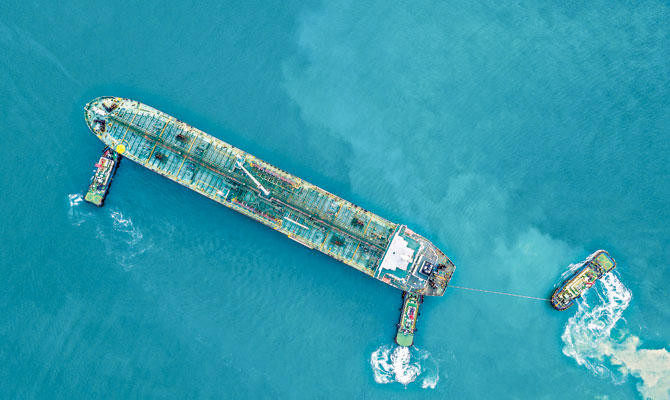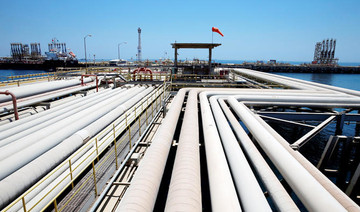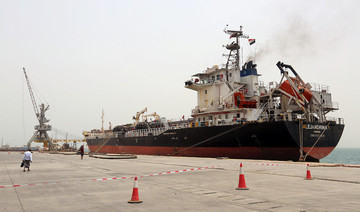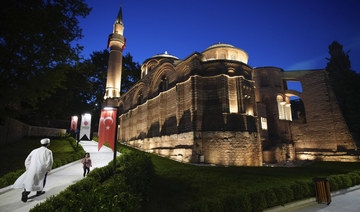LONDON: Houthi militia attacks on Saudi oil tankers in the Red Sea’s Bab Al-Mandeb strait have heightened regional tensions and sent shockwaves through global energy markets.
Saudi Arabia’s decision to temporarily halt oil shipments via the key waterway has also triggered concerns that the cost of transporting oil through increasingly risky Gulf waters could rise if the security of the route does not improve, analysts said.
Riyadh said on Thursday that it was suspending oil shipments in the strategic shipping lane following attacks on two Saudi oil tankers on Wednesday by Yemen’s Houthi forces, which are backed by Iran.
Khalid Al-Falih, the Saudi energy minister, said that the oil shipments would be halted until “the situation becomes clearer and the maritime transit through Bab Al-Mandeb is safe.”
Saudi Arabia exports an estimated 500,000 to 700,000 barrels per day through Bab Al-Mandeb, according to Reuters reports.
The Kingdom also transports oil via a pipeline to the Saudi city of Yanbu on the Red Sea, which supplies Europe and North America.
The attacks come just a few weeks after Iran threatened to close the Strait of Hormuz, a waterway that carries around a fifth of the world’s oil supplies.
The threat was made in retaliation to US President Donald Trump’s plan to reinstate sanctions against the country. Trump withdrew from the 2015 Iran deal brokered by Europe, the US and other global powers, in May — a move that both Saudi Arabia and the UAE backed.
Saudi Arabia and Iran have been entangled in a three-year proxy war in Yemen, with Saudi Arabia claiming that Iran has destabilized the region by arming Houthi forces in the conflict-ridden state.
Both Iran and the Houthi forces reject the claim.
The Houthis have previously threatened to block the straits, and said on Thursday that they have the ability to attack Saudi ports.
“This is a significant escalation in the conflict,” said Ali Vaez, director at the Iran Project, International Crisis Group, based in Washington DC.
“If a Saudi or Emirati vessel or tanker is hit and lives are lost, Riyadh and Abu Dhabi, along with their allies in Washington, might choose to retaliate directly against Iran, which could trigger a wider regional conflagration,” Vaez said.
“Iran is not a passive actor. If the US and its allies push it to a corner, it will eventually lash out through its partners and proxies throughout the region, exacerbating current tensions,” he said.
Ghanem Nuseibeh, founder of strategy consultancy Cornerstone Global Associates, agreed that the risks of further regional conflict had grown.
“There will be more pressure on Iran to secure the straits, but with the way the Iranian regime is responding to American and regional calls for calm, this is getting less and less likely. That is gradually increasing the chances of a military confrontation that could quickly escalate into an all-out war to have the straits resecured.”
The security issues will also have an impact on the shipping business, with a potential increase in the cost of insuring cargo.
Ships in the region will not only continue to deal with the ongoing threat of pirates that lurk off the coast of Yemen and Somalia, but now will also have to factor in the threat of the Yemen conflict spilling over into the seas.
Rajesh Verma, a tanker shipping analyst at shipping consultancy Drewry, said: “If the risk of attack on ships carrying Saudi cargo persists, there are two options for shipping companies: Either change the route or bear the additional cost of war risk insurance premium.
“Insurance premiums would increase if ships opt for the Red Sea route given the heightened risk of attack on vessels carrying Saudi cargo,” he said, estimating that costs may increase by 20-25 percent from the normal rate.
The alternative would be to re-route vessels around Africa and the Cape of Good Hope.
“The voyage distance — and thus shipping cost — however will be significantly higher in this case. For a tanker carrying Saudi crude from Ras Tanura to Rotterdam, sea days on front haul alone will increase from 21 via Red Sea and Suez canal to 36 via the Cape,” he said.
The temporary halting of Saudi oil shipments caused the oil price to jump initially on Thursday.
“The news that Saudi Arabia suspended oil shipments in response to an attack on two of the country’s tankers appears to have initially inspired some increased demand for oil, with WTI climbing back above $69 in the early hours of Thursday trade,” said Jameel Ahmad, global head of currency strategy and market research at FXTM.
He said that it was possible investors might price in some geopolitical risk premium into the oil markets following the news.
Others think this uptick is likely to be short-lived, with oil prices set to decline in the long term.
“Other factors, such as increased OPEC supplies and weakening global oil demand, mean that we still expect oil prices to fall over the next 18 months,” said Jason Tuvey, emerging markets economist at Capital Economics, in a research note on Thursday.
Cormac McGarry, maritime analyst at specialist risk consultancy Control Risks, said: “The Houthis have targeted Saudi tankers in the Red Sea before, notably the Abqaiq in April, and this incident demonstrates their continued capability to do so.
“But the Houthis are less likely to target vessels that are not affiliated with coalition states involved in Yemen. Doing so would draw more international forces, which are committed to freedom of navigation in the Red Sea, against them,” he said.


























